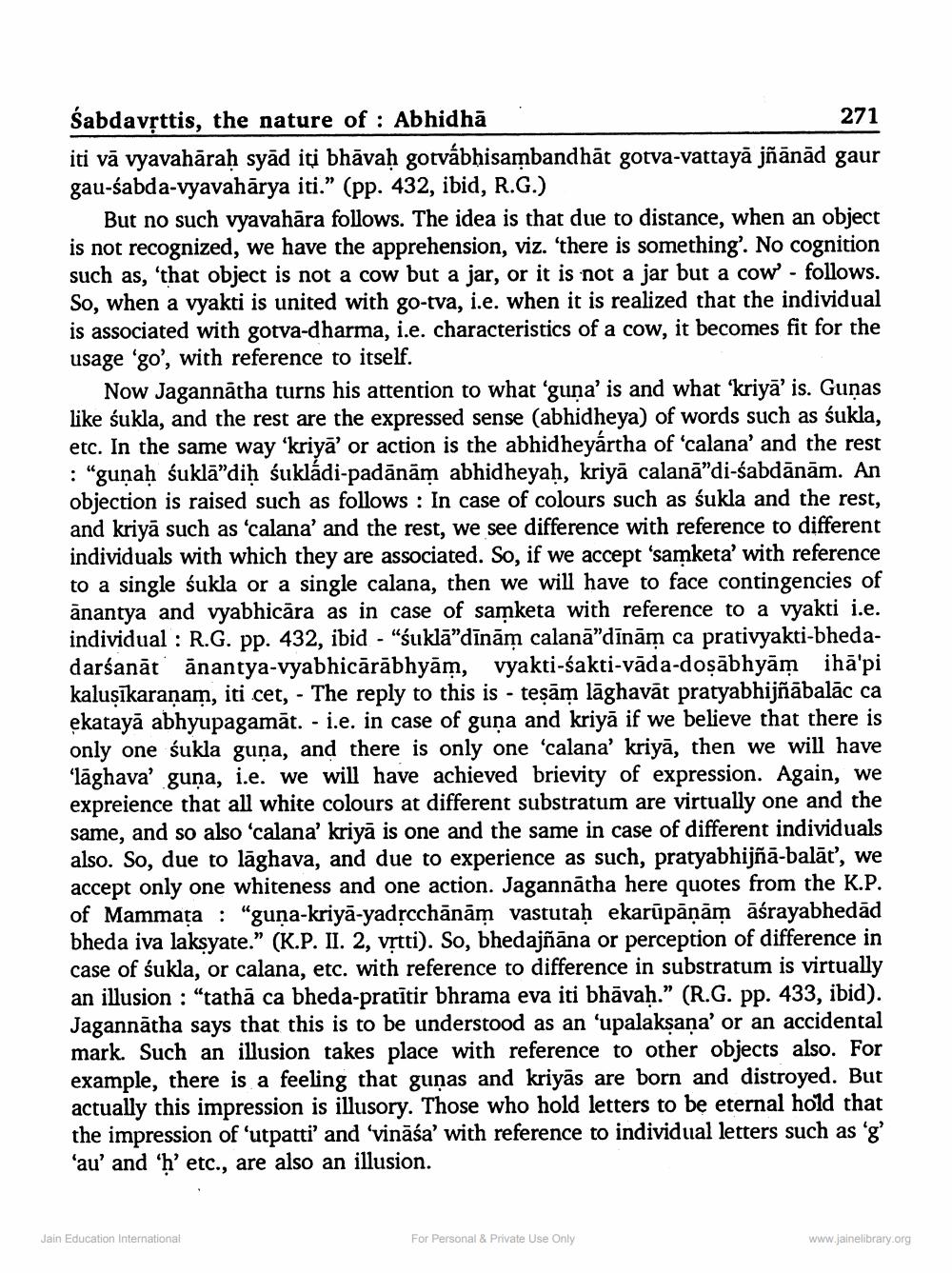________________
Śabdavșttis, the nature of : Abhidhā
271 iti vă vyavahāraḥ syād iti bhāvaḥ gotvábhisambandhāt gotva-vattayā jñānād gaur gau-sabda-vyavahārya iti.” (pp. 432, ibid, R.G.)
But no such vyavahāra follows. The idea is that due to distance, when an object is not recognized, we have the apprehension, viz. 'there is something'. No cognition such as, 'that object is not a cow but a jar, or it is not a jar but a cow - follows. So, when a vyakti is united with go-tva, i.e. when it is realized that the individual is associated with gotva-dharma, i.e. characteristics of a cow, it becomes fit for the usage 'go', with reference to itself. Now Jagannātha turns his attention to what 'guna' is and what ‘kriya' is. Gunas
a, and the rest are the expressed sense (abhidheya) of words such as śukla, etc. In the same way ‘kriyā' or action is the abhidheyártha of 'calana' and the rest : "gunaḥ śuklā”diḥ śukládi-padānām abhidheyah, kriyā calanā"di-sabdānām. An objection is raised such as follows : In case of colours such as śukla and the rest, and kriyā such as 'calana' and the rest, we see difference with reference to different individuals with which they are associated. So, if we accept 'samketa' with reference to a single śukla or a single calana, then we will have to face contingencies of ānantya and vyabhicāra as in case of samketa with reference to a vyakti i.e. individual : R.G. pp. 432, ibid - "śuklā"dīnām calanā"dīnām ca prativakti-bhedadarśanātānantya-vyabhicārābhyām, vyakti-sakti-vāda-dosābhyām ihā'pi kalusīkaranam, iti cet, - The reply to this is - tesām lāghavāt pratyabhijñābalāc ca ekatayā abhyupagamāt. - i.e. in case of guna and kriyā if we believe that there is only one śukla guņa, and there is only one 'calana’ kriyā, then we will have ‘lāghava' guna, i.e. we will have achieved brievity of expression. Again, we expreience that all white colours at different substratum are virtually one and the same, and so also 'calana' kriyā is one and the same in case of different individuals
o. So, due to lāghava, and due to experience as such, pratyabhijñā-balāt, we accept only one whiteness and one action. Jagannātha here quotes from the K.P. of Mammata : "guna-kriya-yadrcchānām vastutah ekarūpānām āśrayabhedad bheda iva laksyate.” (K.P. II. 2, vrtti). So, bhedajñāna or perception of difference in case of śukla, or calana, etc. with reference to difference in substratum is virtually an illusion : “tathā ca bheda-pratītir bhrama eva iti bhāvah.” (R.G. pp. 433, ibid). Jagannātha says that this is to be understood as an 'upalaksana' or an accidental mark. Such an illusion takes place with reference to other objects also. For example, there is a feeling that guņas and kriyās are born and distroyed. But actually this impression is illusory. Those who hold letters to be eternal hold that the impression of 'utpatti' and 'vināśa' with reference to individual letters such as 'g' 'au' and 'h' etc., are also an illusion.
Jain Education International
For Personal & Private Use Only
www.jainelibrary.org




